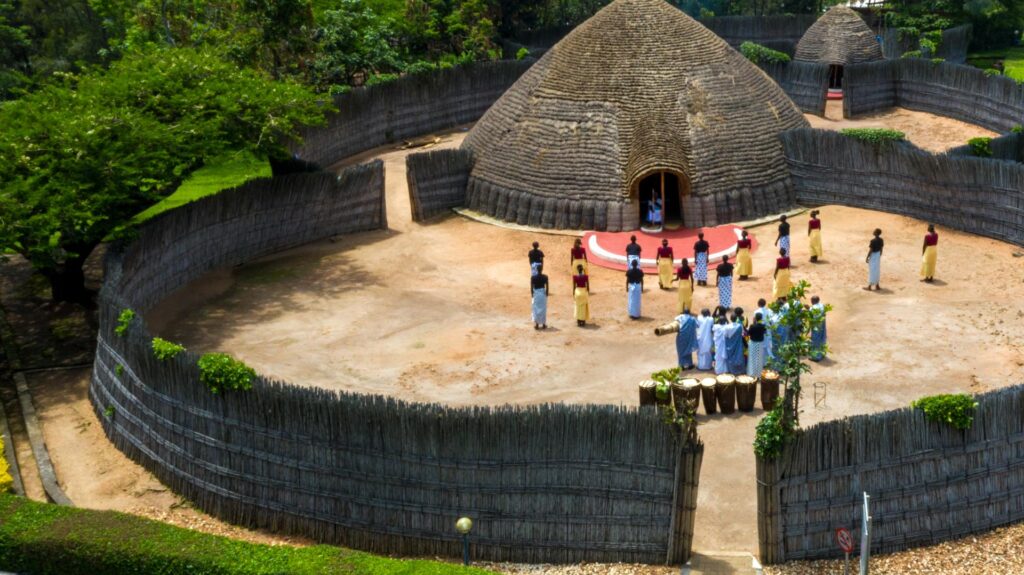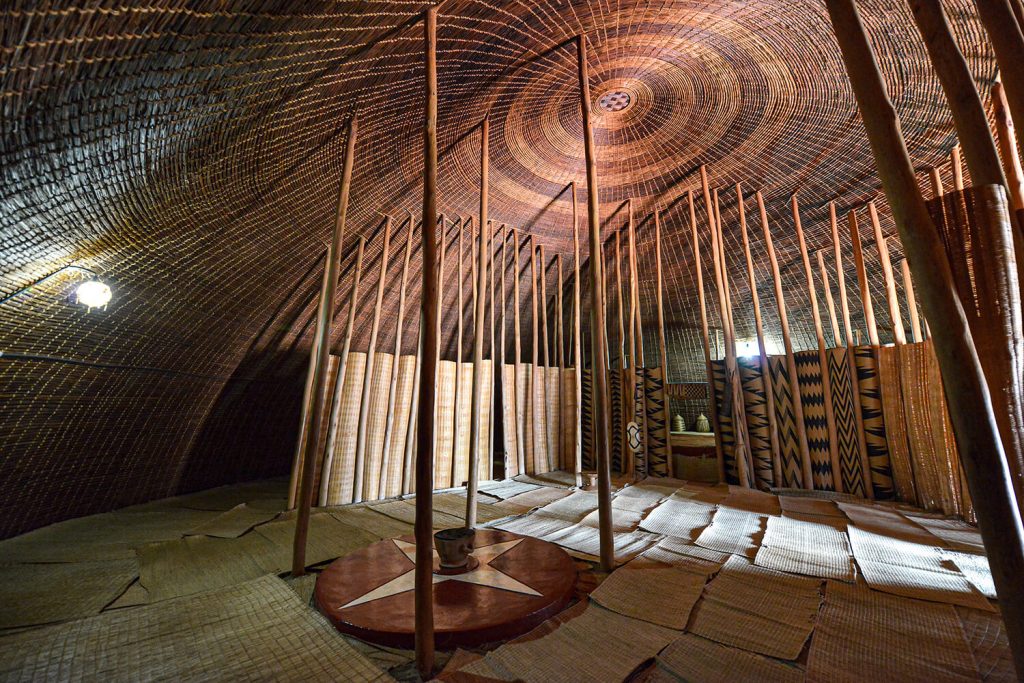Nyanza King’s Palace Museum
The Nyanza King’s Palace Museum, or Urukali Palace Museum, is situated in the Nyanza district in Rwanda’s southern province. This cultural heritage site provides tourists with insight into Rwanda’s pre-colonial history and traditional monarchy. The King’s Palace served as the royal residence of the Rwandan monarchy before to the nation’s shift to a constitutional monarchy and then a republic. The palace functioned as the locus of authority for the Rwandan monarchs (termed Mwami) and was a significant political and cultural hub. The museum is a recreation of the ancient royal palace, constructed in the traditional Rwandan architectural style of locally produced materials, including wood, thatch, and mud. The palace complex comprises multiple structures, including the primary royal home, royal courtrooms, audience halls, and traditional huts.

The traditional palace has models of customary residences, with three huts constructed from mud walls and grass-thatched roofs. The first hut belonged to the king and was perpetually protected by his bodyguards. A secondary residence was owned by a young virgin woman responsible for milking the cows and preserving the milk. A third residence was owned by a young celibate man responsible for the production and storage of booze for the monarch. Visitors can explore each house to gain insight into the lifestyle of the Rwandan people and comprehend the significance of various structures within a typical Rwandan dwelling.
The contemporary palace is an impressive edifice that exemplifies the magnificence and grandeur of the Rwandan royalty. It was constructed by Belgian architects for King Mutara III. The Palace comprises multiple structures, including residential quarters, several bedrooms, including one for the king’s mother during her visits, and a basement intended for the preservation of alcohol and milk at low temperatures.

The palace was restored to its 19th-century condition as a prototype, constructed entirely with traditional materials. The Long-horned royal cows, known as “Inyambo,” were recently introduced, as cows are integral to Rwandan culture and historically symbolize the king’s majesty. Visitors are consistently enthralled by the procession of these royal cows, renowned for their impressive long horns, stature, gentle disposition, and traditional poetry.
The museum is equally intriguing as the quadrupeds located in the rear. It presents a replica of a king’s palace featuring a thatched roof, royal hut arrows, utensils, bows, drums, shields, and a fresh milk hut traditionally managed by an unmarried lady. Visitors may also investigate the colonial-style mansion that formerly served as the royal abode of King Mutara III Rudahigwa. The interior decor is really impressive, blending Rwandan motifs with European-style furnishings, some of which were formerly held by the king. Visiting the king’s palace museum provides an opportunity to explore the profound history of Rwanda and its traditional lifestyle. Visitors on Rwandan cultural tours can also explore other intriguing renovated cultural sites to gain deeper insights into Rwanda’s history and culture, such as the Kigali Genocide Memorial.
Tourists can integrate their cultural discovery with wildlife safaris, as visitors may partake in exhilarating game drives in Akagera National Park to enhance their life experiences and adventure safaris. Akagera National Park is the sole savannah national park in Rwanda, home to a diverse array of captivating wildlife, including the African Big Five: buffaloes, lions, rhinos, elephants, and leopards. Additional species comprise giraffes, topis, zebras, bushbabies, hippos, crocodiles, Defassa waterbucks, Bohor reedbucks, oribis, semi-aquatic sitatungas, and elands. During the game drives, you will have the opportunity to observe nearly all the wildlife species inhabiting the park, including avian species such as the Pied Crow, Long-Crested Eagle, Viellot’s Black Weaver, Fish Eagles, Grey-Backed Fiscal, Cattle Egret, Black-Headed Ibis, Hamerkop, Sacred Ibis, Hadada Ibis, and the Augur Buzzard, among others.
Visitors may also choose chimpanzee trekking, which is the most gratifying activity to enhance your vacation in Rwanda. This intriguing primate species can be observed in Nyungwe Forest National Park. Visitors to the park can also engage in a canopy walk approximately 50 meters above ground to gain a profound understanding of the park’s stunning landscape, avian species, and observe various forest-dwelling animals, including duikers, golden cats, klipspringers, impalas, bushbucks, buffaloes, elephants, bush pigs, giant forest hogs, blotched servals, carnivorous genets, Congo clawless otters, servals, Felis, black-fronted duikers, western tree hyraxes, and numerous others.
Mountain gorilla trekking is a distinctive and exceptional activity in Rwanda, renowned for its gorilla trekking conducted in the Virunga Mountains in Volcanoes National Park, situated in the northwest of the province. Trekking for mountain gorillas is exclusively conducted in three countries: Uganda, the Democratic Republic of Congo, and Rwanda. In Volcanoes National area, one may also experience the uncommon Golden monkey tracking, and the area provides exceptional chances for birdwatching, hosting over 200 bird species, among others.
Nyanza King’s Palace Museum, If you are an avian enthusiast, you may also encounter many bird species that inhabit the region. Rwanda is home to over 700 bird species, distributed across its diverse landscapes, including swamps, lakes, rivers, and vegetation. Among these, more than 20 species are endemic to the Albertine Rift Valley, such as the Rwenzori Apalis, Dusky Crimson-wing, Red-faced Woodland, Rwenzori Batis, Dusky Turtle Dove, Rwenzori Double-collared Sunbird, African Long-eared Owl, Double-toothed Barbet, Grey Crowned Crane, Spur-winged Lapwing, Grey-backed Fiscal, Black-headed Heron, and Egret.
Additionally, one may explore the twin lakes of Rwanda, namely Lake Butera and Lake Ruhondo, for leisure following a day of activities. These lakes provide a plethora of aquatic pursuits, including sport fishing, boat cruises, canoeing, swimming, and kayaking, among others.
